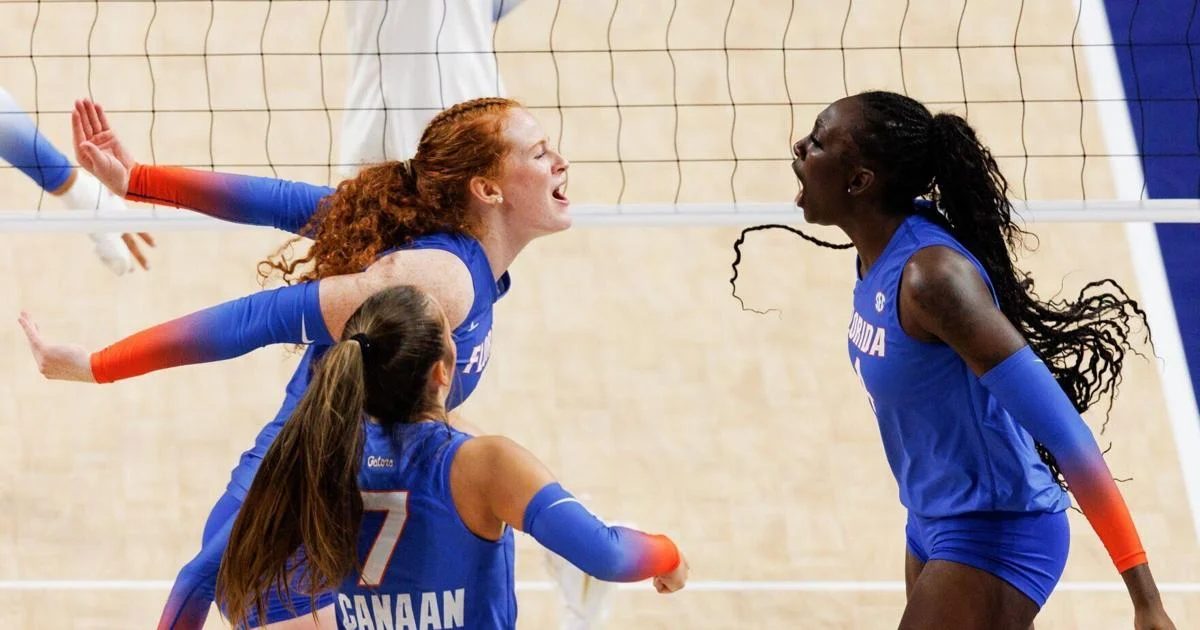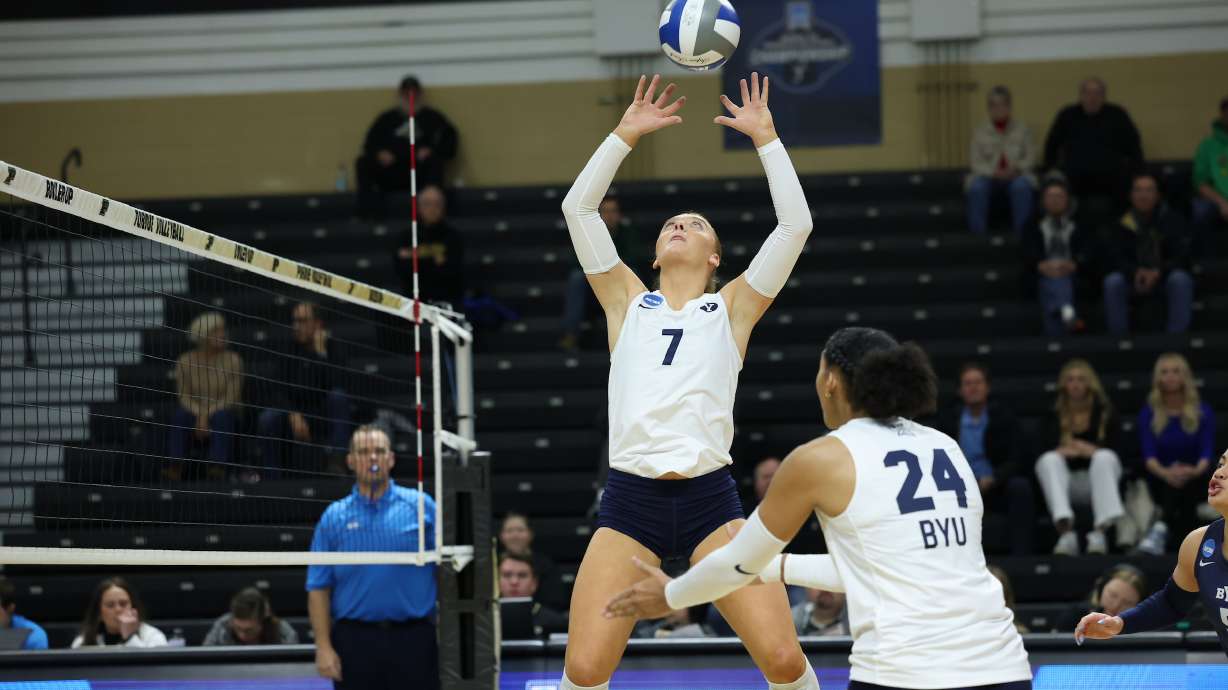Jaela Auguste’s path to the University of Wisconsin volleyball team runs through Osijek, Croatia.
kAmpF8FDE6 H2D 2 >6>36C @7 E96 &$p &`h E62> E92E H@? E96 ux’q (@C=5 r92>A:@?D9:A 😕 rC@2E:2 😕 a_ab] ~?6 @7 96C E62>>2E6D H2D r92C=:6 uF6C3C:?86C]k^Am

kAm%96 EH@ 7@C>65 2 3@?5 DEC@?8 6?@F89 E92E H96? pF8FDE6 6?E6C65 E96 EC2?D76C A@CE2= 27E6C 96C D@A9@>@C6 D62D@? 2E u=@C:52[ E96 ?@E:@? @7 C6F?:E:?8 H:E9 uF6C3C:?86C AC@G65 E@@ 8@@5 E@ A2DD FA]k^Am
kAm“(6 H@? H@C=5D E@86E96C 😕 rC@2E:2[ 2?5 x ;FDE C6>6>36C FD 36:?8 2EE24965 2E E96 9:A[” pF8FDE6 D2:5 😕 2 A9@?6 :?E6CG:6H] “(6 92G6 366? 4=@D6 2?5 8@@5 7C:6?5D 6G6C D:?46 E96?]k^Am
People are also reading…
kAm“$96’D 366? E6==:?8 >6 E96 E9:?8D x ?665 E@ 962C 2?5 2?DH6C65 E96 BF6DE:@?D x 925 23@FE (:D4@?D:?[ H9:49 >256 >6 2 H9@=6 =@E >@C6 DFC6 2?5 4@?7:56?E 😕 >J 564:D:@? E@ 8@ E@ (:D4@?D:?]”k^Am
kAm%96 q2586CD 5:5 =2?5 2?@E96C A=2J6C 7C@> E96 A@CE2= |@?52J 😕 k2 9C67lQ9EEADi^^32586C6IEC2]4@>^DA@CED^G@==6J32==^H:D4@?D:?\G@==6J32==\=2?5D\42=:7@C?:2\@FED:56\9:EE6C\7C@>\EC2?D76C\A@CE2=^2CE:4=60h22e_a_a\7`cc\c5bg\2cga\`ba7bd4e2h3e]9E>=Q E2C86ElQ03=2?
kAmpF8FDE6[ 2 e\a >:55=6 3=@4<6C H9@ 62C?65 E9:C5 E62> p’rp p==\p>6C:42? 9@?@CD E9:D D62D@?[ k2 9C67lQ9EEADi^^32586C6IEC2]4@>^DA@CED^G@==6J32==^H:D4@?D:?\G@==6J32==\=2?5D\2==\2>6C:42?\7C@>\EC2?D76C\A@CE2=\E@\C6A=246\56A2CE:?8\DE2C^2CE:4=60a5d6cccg\_bbe\ce2c\2c53\d625db4`a`hd]9E>=Q E2C86ElQ03=2?

kAm“x H@F=5 D2J Wx 49@D6X (:D4@?D:? 3642FD6 :E H2D E96 D49@@= E92E >256 >J 7FEFC6 =@@< E96 3C:89E6DE[” D96 D2:5] “x H@F=5 D2J :E H@F=5 ;FDE 36 E96 D>2CE6DE 564:D:@? 7@C >6 7@C E96 C6DE @7 >J 4@==68:2E6 42C66C[ E96 H2J E92E E96 AC@8C2> CF?D 2?5 E96 H2J E92E E96J 42CCJ E96>D6=G6D] %96J 2C6 4@?D:DE6?E=J 2 E@A `_ E62> 2?5 E96J 2=H2JD 92G6 2 =@E @7 8@@5 E9:?8D 8@:?8 7@C E96>] $@ H9J ?@E 36 2 q2586Cn”k^Am
kAmpF8FDE6 D2:5 D96 962C5 7C@> >@C6 D49@@=D E92? D96 4@F=5 4@F?E 27E6C D96 6?E6C65 E96 A@CE2=[ H:E9 (:D4@?D:? 36:?8 2>@?8 E96 7:CDE E@ 4@?E24E 96C] $96 E2=<65 E@ 23@FE D6G6? D49@@=D 2?5 D@@? 56E6C>:?65 E92E (:D4@?D:? 925 H92E D96 H2D =@@<:?8 7@C]k^Am
kAm“*@F 5@ J@FC C6D62C49 7@C 2== E96 D49@@=D 2?5 J@F =@@< 2E E96 E9:?8D E92E 2C6 :>A@CE2?E E@ J@F 2?5 D66 H92E 7:ED J@F 36DE[ H92E >2<6D J@FC 7FEFC6 =@@< E96 3C:89E6DE[” pF8FDE6 D2:5]k^Am
kAm(:D4@?D:? 4@249 z6==J $9677:6=5 😀 6I4:E65 23@FE 92G:?8 pF8FDE6 ;@:? E96 AC@8C2> 368:??:?8 E9:D DAC:?8]k^Am
kAmQ$96 😀 @?6 @7 E96 >@DE 5J?2>:4 2EE24<6CD 😕 E96 4@F?ECJ[” $9677:6=5 D2:5] “w6C D=:56 😀 =6E92=[ 2?5 D96 😀 2=D@ 8C62E @77 @7 EH@ 766E] y]y] 42? 2=D@ 62E FA A2DD6CD 7C@> 369:?5 E96 D6CG:46 =:?6] xV> =@@<:?8 7@CH2C5 E@ 92G:?8 96C 96C6 E9:D DAC:?8]Qk^Am
kAmpF8FDE6 D2:5 D96 9:E :E @77 H:E9 $9677:6=5 C:89E 2H2J H96? E96J E2=<65]k^Am

kAm“x’G6 925 D@>6 AC6EEJ 8@@5 4@?G6CD2E:@?D H:E9 z6==J[” D96 D2:5] “x E9:?< 96’D G6CJ 7F??J]”k^Am
kAm~? E96 D6C:@FD D:56[ E96 E9:?8 E92E DECF4< pF8FDE6 H2D 9@H 96 56D4C:365 q2586CD 72?D]k^Am
kAm“x =@G65 H96? 96 H@F=5 E2=< 23@FE E96 72?D 2?5 9@H 5:692C5 E96J 2C6 7@C G@==6J32== 2?5 9@H 3:8 @7 2 G@==6J32== D49@@= :E :D[” pF8FDE6 D2:5] “#62=:K:?8 9@H >2?J A6@A=6 2C6 A2DD:@?2E6 23@FE G@==6J32== E96C6 86ED >6 G6CJ 6I4:E65 3642FD6 x’G6 ?6G6C 366? 2E 2 ECF6 G@==6J32== D49@@=] x 5@?’E E9:?< E96 $tr 😀 E92E 3:8 @? G@==6J32==]”k^Am
kAm“%96 6?6C8J 😕 E92E A=246 H2D ;FDE F?C62=[” D96 D2:5] “%96J A24<65 :E 2?5 :E H2D G6CJ 7F?] |6 8@:?8 324< 2?5 7@CE9 A=2J:?8 H:E9 |:>: Wr@=J6CX 2?5 36:?8 😕 E92E 4@>A6E:E:G6 6?G:C@?>6?E[ x E9@C@F89=J 6?;@J65 :E]”k^Am

kAm“r92C=:6 H2D ;FDE 7665:?8 E96 >:55=6 2?5 7665:?8 E96 >:55=6[” D96 D2:5] “%92E’D =:E6C2==J A6C764E 7@C >6[ 2?5 x E9:?< x 42? 7:E 😕 8C62E H:E9 E96 AC@8C2>]k^Am
kAm“x E9:?< x 4@F=5 36 2 H2J 3:886C A=2J6C E92? x 2> C:89E ?@H] x H@F=5 =@G6 E@ 8C@H >J 82>6 5676?D:G6=J[ 2?5 x E9:?< E92E x 2> G6CJ 8@@5 @776?D:G6=J] qFE :7 x 86E E96C6 5676?D:G6=J[ x 766= =:<6 x 4@F=5 36 F?DE@AA23=6] x ;FDE @H x 4@F=5 8C@H >J 82>6 2 =@E >@C6 7C@> H96C6 x 2> C:89E ?@H] %96 E9:C5 E62> p==\p>6C:42? H2D 8C62E[ 3FE x ;FDE @H E92E x 42? 5@ >@C6]”k^Am
kAmuF6C3C:?86C 😀 ?@E E96 @?=J q2586C H:E9 H9@> pF8FDE6 😀 72>:=:2C] pD 2 D6?:@C[ D96 H2D 2 E62>>2E6 @7 a_ae C64CF:E w2==6 %9@>AD@? 2E vC2?5 ~2
kAm“x 92G6 E2=<65 E@ w2==6[ 2?5 E92E 5:5 A=2J 2 A2CE 😕 >J 564:D:@?[” pF8FDE6 D2:5] “x @H |:>: 😀 2 8C62E @FED:56[ 2?5 H:E9 96C =62G:?8[ H6 H@F=5 92G6 E@ 92G6 D@>63@5J 4@>6 😕 2?5 7:== E9@D6 D9@6D] p?5 x @H w2==6 42? 5@ H92E D96 AFED 96C >:?5 E@]”k^Am
kAmpF8FDE6 4@>6D 7C@> 2? 2E9=6E:4 72>:=J] w6C >@E96C[ p=:D92[ H2D @? E96 G@==6J32== 2?5 EC24< E62>D 2E $2> w@FDE@? $E2E6[ 2?5 96C 72E96C[ (:=56C[ A=2J65 32D<6E32== 2E $2> w@FDE@? $E2E6 2?5 =2E6C H:E9 E96 w2C=6> v=@36EC@EE6CD]k^Am

kAm“w6 A=2J65 FA F?E:= x H2D 23@FE f[” D96 D2:5] “x C6>6>36C 8@:?8 E@ 9:D 82>6D[ 2?5 x C6>6>36C 8@:?8 5@H? 2 C65 42CA6E @?46 @C EH:46 H:E9 9:> 2?5 9:D E62>>2E6D] p?5 x C6>6>36C 36:?8 D42C65 @7 E92E =:EE=6 >2D4@E[ v=@3:6] x 92G6 =:EE=6 >6>@C:6D @7 E92E]”k^Am
kAmpF8FDE6 4@>A6E65 😕 EC24< 7@C ?:?6 J62CD[ 6I46==:?8 😕 E96 9:89 ;F>A H:E9 2 A6CD@?2= 36DE @7 d\`_]k^Am
kAm“x 5:5 EC24< 7@C >@DE @7 >J =:76[ 2?5 x E9@F89E x H2D 8@:?8 E@ 8@ E@ 4@==686 7@C EC24<[” D96 D2:5] “qFE E96? x 6?565 FA 86EE:?8 :?E@ G@==6J32== 2E E96 =2DE D64@?5 2?5 6?565 FA 36:?8 C62==J 8@@5 2E :E 2?5 =@G65 :E]k^Am
kAm“x7 x’> 36:?8 4@>A=6E6=J 9@?6DE[ x AFCDF65 G@==6J32== 3642FD6 :E H2D :?5@@CD 2?5 x H2D D@ D:4< @7 36:?8 😕 E96 DF?] ‘@==6J32== 😀 2=D@ 7F?] xE H2D 7F? E@ 86E E@ @H A6@A=6 2?5 24EF2==J H@C< H:E9 @E96C A6@A=6] ‘@==6J32== 😀 2 DA@CE H96C6 J@F 92G6 E@ 56A6?5 @? @E96CD] xE E6DE65 >J 23:=:EJ E@ H@C< H:E9 @E96CD[ 2?5 x’> G6CJ 8C62E 2E 5@:?8 :E]”k^Am
kAmpF8FDE6 BF:4<=J 3642>6 8@@5 6?@F89 2E G@==6J32== E92E D96 H2D C2?<65 2D E96 }@] `f C64CF:E 3J !C6As:8 2?5 49@D6 E@ 8@ E@ u=@C:52 E@ A=2J 7@C =686?52CJ 4@249 |2CJ (:D6] qFE (:D6 C6E:C65 27E6C =2DE D62D@?[ 2?5 pF8FDE6 49@D6 E@ DE2J 6G6? E9@F89 D96 D2:5 E96 A=2J6CD H6C6 5:D2AA@:?E65 H96? 2DD:DE2?E 4@249 s2G6 q@@D 72:=65 E@ 86E E96 ;@3[ H9:49 H6?E E@ 7@C>6C |2CBF6EE6 4@249 #J2? %96:D]k^Am

kAm“x 82G6 E96 D62D@? 2 ECJ[ 3FE x ;FDE 76=E =:<6 :E H2D E:>6 7@C >6 E@ =62G6 3642FD6 x 6H E92E x 4@F=5 244@>A=:D9 3:886C E9:?8D 😕 E96 G@==6J32== H@C=5 2?5 D9@H A6@A=6 H92E x’> 24EF2==J 42A23=6 @7 2E 2 C62= G@==6J32== D49@@=[” pF8FDE6 D2:5]k^Am
kAm“x H6:8965 @FE >J @AE:@?D[ 3FE x 76=E =:<6 E9:D H2D E96 36DE 564:D:@? 7@C >6[” D96 D2:5] “!$& H2D 2 AC6EEJ 4=@D6 42==[ 3FE x 5:5?’E @H 9@H E92E H@F=5 =@@< 7@C >6 7@C E96 C6DE @7 >J 42C66C] xE ;FDE <:?5 @7 76=E =:<6 x’5 36 9@AA:?8 @? 2 32?5H28@? 2?5 >2<:?8 2 564:D:@? 32D65 @? @E96CD]k^Am
kAm“x ;FDE @H 😕 >J 962CE E92E x >256 E96 C:89E 564:D:@?] x 766= =:<6 H:E9 E9:D 564:D:@?[ x H2?E65 E@ >2<6 2 564:D:@? 7@C >JD6=7 7@C @?46] }@C>2==J x ;FDE ECJ E@ A6@A=6 A=62D6 2?5 >2<6 564:D:@?D 7@C @E96CD[ 2D x’G6 5@?6 😕 E96 A2DE 7@C D@>6 E9:?8D] qFE x ;FDE 76=E =:<6 E9:D H2D 2 8@@5 564:D:@? 7@C >6]”k^Am
kAmtG6? :7 D96 92D E@ =62C? E@ 562= H:E9 2? 6?E:C6=J 5:776C6?E 4=:>2E6]k^Am
kAm“p =@E @7 A6@A=6 92G6 366? E6IE:?8 >6[ 2D<:?8 :7 x’> C625J 7@C E96 4@=5[” D96 D2:5] “x’G6 366? 2D<:?8 2 =@E @7 A6@A=6 23@FE 4@2ED 2?5 H92E’D 36DE E@ 86E] xD :E 42==65 2 A2C<2n x 5@?’E 92G6 2?J 3:8 4@2ED] x >62?[ 2?J] w@A67F==J x’== 36 AC6A2C65]”k^Am
Photos: Wisconsin volleyball 2025 season in photos

Wisconsin outside hitter Grace Egan (32) serves against UW Milwaukee on Tuesday, Sept. 9, 2025 at UW Field House in Madison, Wis.
OWEN ZILIAK,STATE JOURNAL

Wisconsin middle blocker Alicia Andrew (17) is greeted by fans after taking the floor prior to a match against Southern California at the Wisconsin Fieldhouse in Madison, Wis. Sunday, Oct. 19, 2025. JOHN HART, STATE JOURNAL
JOHN HART,STATE JOURNAL

Wisconsin defenders jump to block a spike by Kansas outside hitter Jovana Zelenovic (9) on Friday, Aug. 29, 2025 at Kohl Center in Madison, Wis.
OWEN ZILIAK,STATE JOURNAL

The Wisconsin student section reacts after Wisconsin wins the third set against Kansas on Friday, Aug. 29, 2025 at Kohl Center in Madison, Wis.
OWEN ZILIAK,STATE JOURNAL

Wisconsin setter Charlie Fuerbringer (24) sets the ball for a spike against Texas on Sunday, Aug. 31, 2025 at the Kohl Center in Madison, Wis.
OWEN ZILIAK,STATE JOURNAL

Wisconsin setter Charlie Fuerbringer (24) sets the ball against Eastern Illinois on Thursday, Dec. 4, 2025 at UW Field House in Madison, Wiss.
OWEN ZILIAK,STATE JOURNAL

Wisconsin outside hitter Grace Egan, left, and middle blocker Carter Booth, right, go up for a block against UC-Davis Sept. 4.
OWEN ZILIAK,STATE JOURNAL ARCHIVES

Wisconsin outside hitter Grace Egan (32) and Wisconsin middle blocker Carter Booth (52) yell after a block to win the first set against Purdue on Wednesday, Nov. 19, 2025 at UW Field House in Madison, Wis.
OWEN ZILIAK,STATE JOURNAL

Wisconsin outside hitter Mimi Colyer (15) elevates to contest a ball at the net against Illinois on Thursday, Oct. 2, 2025 at UW Field House in Madison, Wis.
OWEN ZILIAK,STATE JOURNAL

Wisconsin outside hitter Mimi Colyer (15) is introduced prior to the match against Illinois on Thursday, Oct. 2, 2025 at UW Field House in Madison, Wis.
OWEN ZILIAK,STATE JOURNAL

Wisconsin setter Charlie Fuerbringer (24) high-fives kids lined up before playing UC-Davis on Thursday, Sept. 4, 2025 at UW Field House in Madison, Wis.
OWEN ZILIAK,STATE JOURNAL

Wisconsin outside hitter Grace Egan (32) hits the floor after saving the ball from touching the ground against Texas on Sunday, Aug. 31, 2025 at the Kohl Center in Madison, Wis.
OWEN ZILIAK,STATE JOURNAL

Wisconsin outside hitter Mimi Colyer (15) helps setter Charlie Fuerbringer (24) off the floor after losing a point to Texas on Sunday, Aug. 31, 2025 at the Kohl Center in Madison, Wis.
OWEN ZILIAK,STATE JOURNAL

Wisconsin head coach Kelly Sheffield huddles with his senior players following the teamÕs win over UNC during a second round NCAA Tournament match between the teams at the Wisconsin Fieldhouse in Madison, Wis. Friday, Dec. 5, 2025. JOHN HART, STATE JOURNAL
JOHN HART,STATE JOURNAL

Wisconsin outside hitter Grace Egan (32) watches as the ball flies in the air before a serve against Notre Dame on Sunday, Aug. 17, 2025 at UW Field House in Madison, Wis.
OWEN ZILIAK,STATE JOURNAL

Wisconsin outside hitter Grace Egan (32) goes up for a spike against UC-Davis on Thursday, Sept. 4, 2025 at UW Field House in Madison, Wis.
OWEN ZILIAK,STATE JOURNAL

Wisconsin players react after a Minnesota touch goes out of bounds on Wednesday, Nov. 5, 2025 at UW Field House in Madison, Wis.
OWEN ZILIAK,STATE JOURNAL

The Wisconsin bench celebrates after a point against UW Milwaukee on Tuesday, Sept. 9, 2025 at UW Field House in Madison, Wis.
OWEN ZILIAK,STATE JOURNAL

Wisconsin outside hitter Mimi Colyer (15) attempts to spike over three Iowa defenders on Sunday, Nov. 23, 2025 at UW Field House in Madison, Wis.
OWEN ZILIAK,STATE JOURNAL

Nebraska middle blocker Rebekah Allick (5) yells after a block on Wisconsin outside hitter Grace Egan (32) on Friday, Oct. 31, 2025 at UW Field House in Madison, Wis.
OWEN ZILIAK,STATE JOURNAL

A young fan smiles after getting a high-five from a Wisconsin player during introductions against Minnesota on Wednesday, Nov. 5, 2025 at UW Field House in Madison, Wis.
OWEN ZILIAK,STATE JOURNAL

Wisconsin outside hitter Una Vajagic (1) dives for a ball flying out of bounds against Michigan on Saturday, Oct.5, 2025 at UW Field House in Madison, Wis.
OWEN ZILIAK,STATE JOURNAL

Wisconsin outside hitter Mimi Colyer (15) is introduced prior to the teamÕs non-conference match against Florida at the Kohl Center in Madison, Wis. Sunday, Sept. 21, 2025. JOHN HART, STATE JOURNAL
JOHN HART,STATE JOURNAL

Wisconsin outside hitter Mimi Colyer (15) blocks a spike against Michigan on Saturday, Oct.5, 2025 at UW Field House in Madison, Wis.
OWEN ZILIAK,STATE JOURNAL

Wisconsin outside hitter Madison Quest (10) emerges from the locker room before playing Michigan on Saturday, Oct.5, 2025 at UW Field House in Madison, Wis.
OWEN ZILIAK,STATE JOURNAL

Wisconsin right side hitter Addy Horner (2) and Wisconsin middle blocker Natalie Wardlow (12) collide trying to set the ball against Nebraska on Friday, Oct. 31, 2025 at UW Field House in Madison, Wis.
OWEN ZILIAK,STATE JOURNAL

Wisconsin outside hitter Mimi Colyer (15) extends to hit a ball going out of bounds against Minnesota on Wednesday, Nov. 5, 2025 at UW Field House in Madison, Wis.
OWEN ZILIAK,STATE JOURNAL

Wisconsin middle blocker Alicia Andrew (17) and right side hitter Wisconsin setter Charlie Fuerbringer (24) put up a block against Indiana outside hitter Jaidyn Jager (24) in the first set of a match at the UW Field House in Madison, Wis. Sunday, Nov. 9, 2025. AMBER ARNOLD, STATE JOURNAL
AMBER ARNOLD STATE JOURNAL

Wisconsin outside hitter Grace Egan (32) lines up a bump after a return by Iowa on Sunday, Nov. 23, 2025 at UW Field House in Madison, Wis.
OWEN ZILIAK,STATE JOURNAL

Wisconsin middle blocker Carter Booth (52) reacts after a point against Kansas on Friday, Aug. 29, 2025 at Kohl Center in Madison, Wis.
OWEN ZILIAK,STATE JOURNAL

Wisconsin players, including Wisconsin middle blocker Alicia Andrew, left, and libero/defensive specialist Kristen Simon (7) celebrate the teamÕs win over UNC during a second round NCAA Tournament match between the teams at the Wisconsin Fieldhouse in Madison, Wis. Friday, Dec. 5, 2025. JOHN HART, STATE JOURNAL
JOHN HART,STATE JOURNAL
Be the first to know
Get local news delivered to your inbox!
Wisconsin outside hitter Mimi Colyer reflects on being the No. 1 draft pick in the MLV draft on Monday, Nov. 23, 2025.

Two more Badgers volleyball players announced Friday that they will enter the transfer portal. Here are the details.

The Badgers coaching staff praised the ability of this freshman to step in for an injured All-American.

The former No. 1 libero in her recruiting class announced on Instagram that she’s entering the transfer portal.

Two players who helped fuel the Badgers’ run to the Final Four earned All-American honors Wednesday.

Kelly Sheffield’s Badgers took us on a ride that ended too soon. How they handled that heartbreaking finale was just as impressive as any of t…

Charlie Fuerbringer and others believed from the start that this group had Final Four potential. But some adversity along the way made Kelly S…

Carter Booth is sorry for her foul-mouth faux pas. But the message behind it requires no apology: She’s doing everything in her power to exten…

The Badgers handedly won the opening set, but the Wildcats roared back to capture a come-from-behind victory to end Wisconsin’s run in the Final Four.

Kelly Sheffield’s Badgers will face Craig Skinner’s Wildcats in the second national semifinal match Thursday, and the opposing coaches were re…

From recovering on the sidelines to delivering in big moments, Una Vajagic’s breakout play is fueling Wisconsin volleyball’s charge to the Final Four.

A tracker of the latest transfer portal additions and losses for the Badgers volleyball team.

The first Badgers player to enter the transfer portal has found a new program. Here are the details.

There is a family connection between the Badgers and their latest signee. Here’s what to know about Wisconsin’s newest addition.















































































